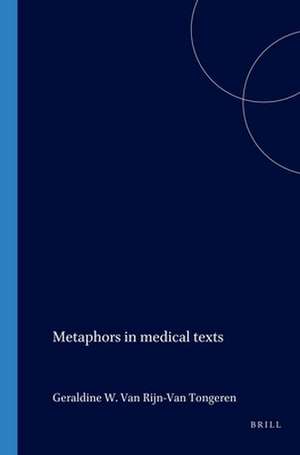Metaphors in medical texts: Utrecht Studies in Language and Communication, cartea 8
Autor Geraldine W. van Rijn-van Tongerenen Limba Engleză Paperback – 31 dec 1996
Preț: 325.75 lei
Nou
Puncte Express: 489
Preț estimativ în valută:
62.34€ • 64.84$ • 51.47£
62.34€ • 64.84$ • 51.47£
Carte indisponibilă temporar
Doresc să fiu notificat când acest titlu va fi disponibil:
Se trimite...
Preluare comenzi: 021 569.72.76
Specificații
ISBN-13: 9789042001275
ISBN-10: 9042001275
Dimensiuni: 150 x 220 mm
Greutate: 0.33 kg
Editura: Brill
Colecția Brill
Seria Utrecht Studies in Language and Communication
ISBN-10: 9042001275
Dimensiuni: 150 x 220 mm
Greutate: 0.33 kg
Editura: Brill
Colecția Brill
Seria Utrecht Studies in Language and Communication
Cuprins
PREFACE. INTRODUCTION. Chapter 1: THEORIES OF METAPHOR. 1.1. I. A. Richards. 1.2. Max Black. 1.3. Lakoff and Johnson. Chapter 2: METAPHOR AND SCIENCE. 2.1. Scientific theories and facts. 2.2. How new scientific facts arise. 2.3. Some further characteristics of thought collectives. 2.4. Fleck's model of three components. Chapter 3: ANALYSIS OF METAPHORS. 3.1. Identifying metaphors. 3.2. Dead and live metaphors. 3.3. Kittay and Lehrer's theory of semantic fields. Chapter 4: METAPHORS AND MEDICAL CONCEPTS. 4.1. Introduction. 4.2. Human beings. 4.3. Society. 4.4. Colonization and invasion. 4.5. Defence and attack. 4.6. Text. 4.7. Machine and mechanism. 4.8. Agents. 4.9. Steps and stages. 4.10. Seeds. 4.11. Some isolated metaphors. 4.12. Summary. Chapter 5: METAPHORS AND MEDICAL THEORIES. 5.1. Introduction. 5.2. TUMOUR CELLS ARE HUMAN BEINGS. 5.3. TUMOUR CELLS INVADE AND COLONIZE. 5.4. CANCER IS WAR. 5.5. A GENOME IS A TEXT. 5.6. A CELL IS A MACHINE. 5.7. CAUSATIVE AGENTS. 5.8. CARCINOGENESIS AND METASTASIS CONSIST OF SEVERAL STEPS. 5.9. TUMOUR METASTASES ARE SEEDS SOWN FROM THE PRIMARY TUMOUR. 5.10. Theories represented by isolated metaphors. 5.11. Highlighting and hiding. 5.12. Interactions between medical science and society. 5.13. Conclusions. Chapter 6: THE FUNCTIONS OF METAPHORICAL EXPRESSIONS IN MEDICAL TEXTS. 6.1. Catachretic metaphors. 6.2. Didactic metaphors. 6.3. Theory constitutive metaphors. 6.4. Changing functions of metaphors. 6.5. Metaphors provide a vocabulary. 6.6. Conclusions. CONCLUSIONS. BIBLIOGRAPHY. Appendix A: Bibliography of medical texts. Appendix B: Examples of metaphorical expressions found in medical texts. Index.















